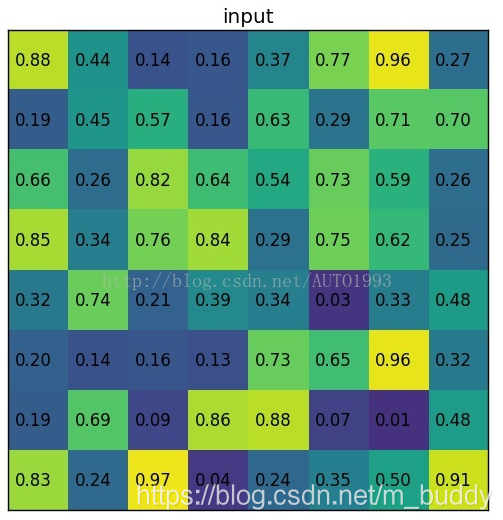關於ROI Pooling Layer的解讀
1. 原理介紹
目標檢測typical architecture 通常可以分為兩個階段:
(1)region proposal:給定一張輸入image找出objects可能存在的所有位置。這一階段的輸出應該是一系列object可能位置的bounding box。這些通常稱之為region proposals或者 regions of interest(ROI)。
(2)final classification:確定上一階段的每個region proposal是否屬於目標一類或者背景。
這個architecture存在的一些問題是:
產生大量的region proposals 會導致performance problems,很難達到實時目標檢測。在處理速度方面是suboptimal。無法做到end-to-end training。這就是ROI pooling提出的根本原因。
ROI pooling層能實現training和testing的顯著加速,並提高檢測accuracy。該層有兩個輸入:從具有多個卷積核池化的深度網路中獲得的固定大小的feature maps;一個表示所有ROI(也可以叫GT)的N*5的矩陣,其中N表示ROI的數目。第一列表示影象index,其餘四列表示其餘的左上角和右下角座標。
ROI pooling具體操作如下:
(1)根據輸入image,將ROI對映到feature map對應位置,對映是根據image縮小的尺寸來的;
(2)按照ROI Pooling輸出的資料的座標,將其對映到上一步中對映的feature區域上,這樣就將原來feature map上的ROI對映劃分成了幾個sections(sections數量與輸出的維度(pooled_w*pooled_h)相同);
(3)對每個sections進行max pooling操作;
這樣我們就可以從不同大小的方框得到固定大小的相應的feature maps。值得一提的是,輸出的feature maps的大小不取決於ROI和卷積feature maps大小,而是取決於該層設定的pooled_h與pooled_w。ROI pooling 最大的好處就在於極大地提高了處理速度。這樣不管給定feature map輸入的大小,使得輸出的資料維度統一,這與SPP-Net的思想類似。
2. ROI pooling的圖文解釋
考慮一個
大小的feature map,一個ROI,以及ROI Pooling之後的輸出大小為
(1)輸入的固定大小的feature map

(2)region proposal 投影之後位置(左上角,右下角座標):(0,3),(7,8)。

(3)將其劃分為(
)個sections(因為輸出大小為
),我們可以得到:

(4)對每個section做max pooling,可以得到:

ROI pooling總結:
(1)用於目標檢測任務;
(2)允許我們對CNN中的feature map進行reuse;
(3)可以顯著加速training和testing速度;
(4)允許end-to-end的形式訓練目標檢測系統。
3. Caffe中的使用與實現
對於ROI Pooling層在Caffe的prototxt中是這樣定義的
layer {
name: "roi_pool5"
type: "ROIPooling"
bottom: "conv5_3"
bottom: "rois"
top: "pool5"
roi_pooling_param {
pooled_w: 7
pooled_h: 7
spatial_scale: 0.0625 # 1/16
}
}
對應的原始碼,這裡已經寫了必要的註釋
template <typename Dtype>
void ROIPoolingLayer<Dtype>::LayerSetUp(const vector<Blob<Dtype>*>& bottom,
const vector<Blob<Dtype>*>& top) {
ROIPoolingParameter roi_pool_param = this->layer_param_.roi_pooling_param();
CHECK_GT(roi_pool_param.pooled_h(), 0)
<< "pooled_h must be > 0";
CHECK_GT(roi_pool_param.pooled_w(), 0)
<< "pooled_w must be > 0";
pooled_height_ = roi_pool_param.pooled_h(); //Pooling之後的height
pooled_width_ = roi_pool_param.pooled_w(); //Pooling之後的width
spatial_scale_ = roi_pool_param.spatial_scale(); //GT標註的縮放比例
LOG(INFO) << "Spatial scale: " << spatial_scale_;
}
template <typename Dtype>
void ROIPoolingLayer<Dtype>::Reshape(const vector<Blob<Dtype>*>& bottom,
const vector<Blob<Dtype>*>& top) {
channels_ = bottom[0]->channels();
height_ = bottom[0]->height();
width_ = bottom[0]->width();
top[0]->Reshape(bottom[1]->num(), channels_, pooled_height_, //輸出的維度是GT標註的n*channels*Pooling_w*Pooling_h
pooled_width_);
max_idx_.Reshape(bottom[1]->num(), channels_, pooled_height_,
pooled_width_);
}
template <typename Dtype>
void ROIPoolingLayer<Dtype>::Forward_cpu(const vector<Blob<Dtype>*>& bottom,
const vector<Blob<Dtype>*>& top) {
const Dtype* bottom_data = bottom[0]->cpu_data(); //卷積的feature map資料
const Dtype* bottom_rois = bottom[1]->cpu_data(); //標註的GT資料
// Number of ROIs
int num_rois = bottom[1]->num(); //標註資料的個數
int batch_size = bottom[0]->num(); //卷積資料
int top_count = top[0]->count(); //輸出資料的大小
Dtype* top_data = top[0]->mutable_cpu_data(); //空間初始化
caffe_set(top_count, Dtype(-FLT_MAX), top_data);
int* argmax_data = max_idx_.mutable_cpu_data();
caffe_set(top_count, -1, argmax_data);
// For each ROI R = [batch_index x1 y1 x2 y2]: max pool over R
for (int n = 0; n < num_rois; ++n) { //遍歷每個GT標註資料
int roi_batch_ind = bottom_rois[0]; //取出GT座標對應當前batch中的index
int roi_start_w = round(bottom_rois[1] * spatial_scale_); //按照影象縮小的尺寸(scale),去計算對應座標在特徵圖上的相對位置
int roi_start_h = round(bottom_rois[2] * spatial_scale_);
int roi_end_w = round(bottom_rois[3] * spatial_scale_);
int roi_end_h = round(bottom_rois[4] * spatial_scale_);
CHECK_GE(roi_batch_ind, 0);
CHECK_LT(roi_batch_ind, batch_size);
int roi_height = max(roi_end_h - roi_start_h + 1, 1); //計算特徵圖上roi的寬高
int roi_width = max(roi_end_w - roi_start_w + 1, 1);
const Dtype bin_size_h = static_cast<Dtype>(roi_height) //計算roi在特徵圖上的寬高與Pooling之後的寬高的比例
/ static_cast<Dtype>(pooled_height_);
const Dtype bin_size_w = static_cast<Dtype>(roi_width)
/ static_cast<Dtype>(pooled_width_);
const Dtype* batch_data = bottom_data + bottom[0]->offset(roi_batch_ind); //取出正在運算的batch
//使用當前GT對應的Pooling結果位置反向到feature map中去做求最大值操作
for (int c = 0; c < channels_; ++c) {
for (int ph = 0; ph < pooled_height_; ++ph) {
for (int pw = 0; pw < pooled_width_; ++pw) {
// Compute pooling region for this output unit:
// start (included) = floor(ph * roi_height / pooled_height_)
// end (excluded) = ceil((ph + 1) * roi_height / pooled_height_)
int hstart = static_cast<int>(floor(static_cast<Dtype>(ph) //計算Pooling之後的資料在
* bin_size_h));
int wstart = static_cast<int>(floor(static_cast<Dtype>(pw)
* bin_size_w));
int hend = static_cast<int>(ceil(static_cast<Dtype>(ph + 1)
* bin_size_h));
int wend = static_cast<int>(ceil(static_cast<Dtype>(pw + 1)
* bin_size_w));
hstart = min(max(hstart + roi_start_h, 0), height_); //計算當前Pooling位置對應feature map的區域
hend = min(max(hend + roi_start_h, 0), height_);
wstart = min(max(wstart + roi_start_w, 0), width_);
wend = min(max(wend + roi_start_w, 0), width_);
bool is_empty = (hend <= hstart) || (wend <= wstart);
const int pool_index = ph * pooled_width_ + pw;
if (is_empty) {
top_data[pool_index] = 0;
argmax_data[pool_index] = -1;
}
for (int h = hstart; h < hend; ++h) { //求出圈定區域的最大值
for (int w = wstart; w < wend; ++w) {
const int index = h * width_ + w;
if (batch_data[index] > top_data[pool_index]) {
top_data[pool_index] = batch_data[index];
argmax_data[pool_index] = index;
}
}
}
}
}
// Increment all data pointers by one channel
batch_data += bottom[0]->offset(0, 1); //當前batch的下一個channel
top_data += top[0]->offset(0, 1); //當前Pooling的下一個channel
argmax_data += max_idx_.offset(0, 1);
}
// Increment ROI data pointer
bottom_rois += bottom[1]->offset(1); //下一個roi區域
}
}
